Taking NMN by under-the-skin injections or oral consumption improves immune cells that attack cancer and virally infected cells in mice.
By Brett J. Weiss
Highlights
As the average human lifespan increases, people are experiencing poor health and age-related diseases longer, incurring major financial and societal costs. One substantial contributing factor to age-related diseases and their progression is degraded immune function. Specifically, NK cells that terminate cancer and virally infected cells become less effective. At present, no remedy exists to restore the function of NK cells during aging. So, compounds that stimulate NK cell activation may prevent age-related ailments or slow their advancement.
Okumura and colleagues from Juntendo University in Japan treated mice with nicotinamide mononucleotide (NMN) to restore NK cell cytotoxicity — the ability to destroy malfunctioning cells. Published in Biomedical Research, NK cell stimulation in mice occurred when NMN was injected (313, 625, or 1250 mg/kg) or orally administered (625 mg/kg) for four days. Notably, the boosted NK cell cytotoxicity didn’t come from their enhanced proliferation or higher NK cell numbers but rather improved NK cell abilities to destroy cancer cells. These findings support that NMN supplementation may boost NK cell immunity and overall tissue health by curtailing the accumulation of precancerous and viral-infected cells as people age.
NAD+ Levels and Immune Function Drop With Age
Many aspects of immunity decline with age, and NK immune cell function is no exception to this phenomenon. The age-related deterioration of immune function with age is linked to levels of an essential molecule called nicotinamide adenine dinucleotide (NAD+), which also declines with age. However, boosting NAD+ levels has been shown to improve immune function in mice. For example, studies have shown that increasing NAD+ levels by inhibiting an NAD+-consuming enzyme improves immunity to attenuate tumors in mice.
The NAD+ precursor NMN helps with age-related disorders like insulin insensitivity and metabolic impairments like obesity in aged mice. Also, since boosting NAD+ levels have been shown to work against tumors in mice, it may also potentially enhance anti-tumor NK cell activity. Figuring out whether NMN has these immunity-restoring effects in NK cells is critical for determining if it is the compound we’ve been looking for to restore their cytotoxicity.
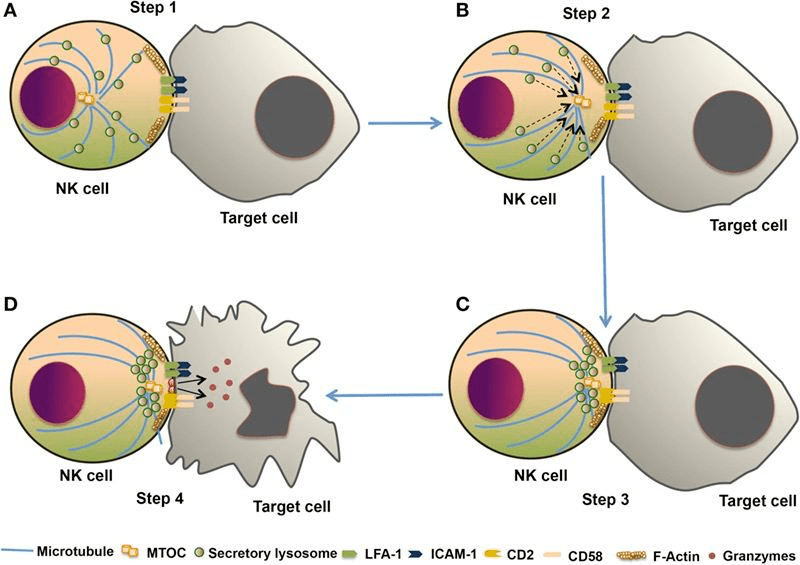
(Paul & Lal, 2017 | Frontiers in Immunology)
The natural killer (NK) immune cell cytotoxic response targets cancer and viral-infected cells. In the first step (A), the NK cell recognizes the target cell and clusters toward it. In the second step (B), the cell reorganizes its internal structure to orient towards the target cell. The third step (C) encompasses the NK cell docking and moving closer to the target cancer cell. The fourth and final step (D) entails the NK cell destroying the target cancer cell so that it bursts open.
Injecting NMN Enhances Mouse Immune Cell Activity
To analyze NMN’s influence on NK cells, Takeda and Okumura injected mice at various ages with NMN and evaluated the activation and cytotoxicity of NK cells. The research duo injected varying doses of 1250, 625, 313, or 125 mg/kg/day of NMN for four days into 36-week old mice and then harvested NK cells from the liver and spleen. These NK cells were then put into a dish with cancer cells at different ratios and were analyzed for cytotoxicity based on the percentage of destroyed cancer cells. These findings indicate that injecting 313 mg/kg or more of NMN enhances aged NK cell capabilities to destroy dysfunctional cells in mice.
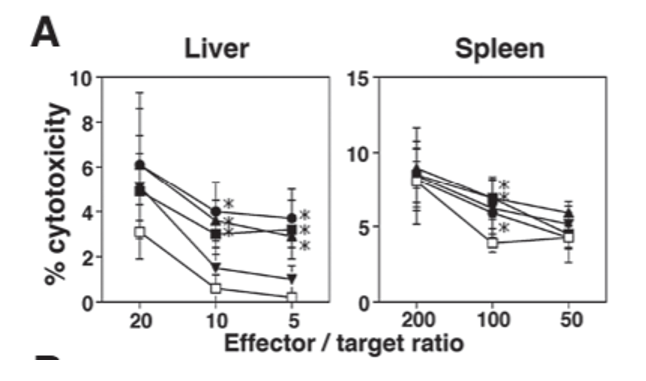
(Takeda & Okumura, 2021 | Biomedical Research)
NMN injections (313 mg/kg/day or greater) significantly enhanced NK cell cytotoxicity in 36-week old mice. The effector/target ratio represents the proportion of NK cells to cancer cells. The cytotoxicity percentage – the percentage of destroyed cancer cells among those analyzed – varied with different effector/target ratios. An effector/target ratio of 10 and 5 showed substantial enhancements of cytotoxicity with NMN in the liver, and an effector/target ratio of 100 was optimal for NMN’s efficacy in the spleen. The upside-down solid triangles represent 125 mg/kg/day doses, the upright and solid triangles show 313 mg/kg/day doses, the solid square signifies 625 mg/kg/day doses, and the solid circle shows 1250 mg/kg/day dose values. These results indicate that NMN’s beneficial cytotoxicity-promoting benefits have tissue-specific effects that optimize at different effector/target cell ratios depending on tissue type.
Oral NMN Dosing Improves Mouse Immune Cell Function
Using the same cytotoxicity measurement method, the research team then sought to determine whether similar benefits come from administering NMN orally. In the 32-week-old mice Takeda and Okumura used for their analysis, 625 mg/kg of orally-supplemented NMN significantly enhanced NK cell cytotoxicity.
Neither injecting or orally dosing NMN increased the NK cell numbers. This result strongly supports that NMN supplementation improves overall NK cell cytotoxicity in mice, because NK cells show improved, potent cancer cell-destroying abilities without becoming more abundant.
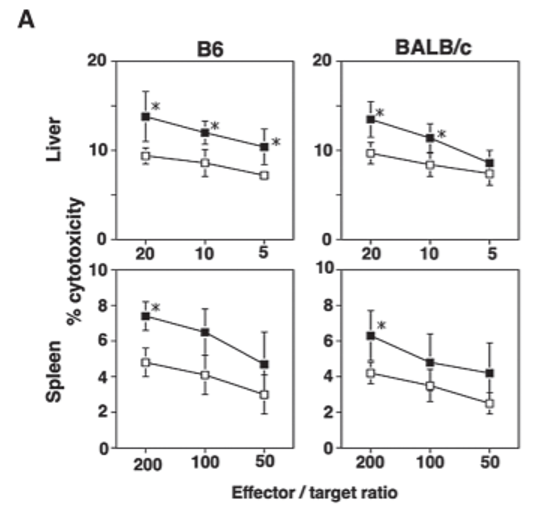
(Takeda & Okumura, 2021 | Biomedical Research)
Oral NMN supplementation with 625 mg/kg/day doses enhances cytotoxicity in the spleen and liver. The optimal effector/target ratios – the proportion of NK cells to cancer cells – were 5, 10, and 20 for the liver and 200 for the spleen. At these ratios, the percentage of destroyed cancer cells, the cytotoxicity percentage, increased substantially at 625 mg/kg/day doses (solid squares on the graphs). These findings show that orally dosing with NMN as well as injections can improve NK cell cytotoxicity in two different mouse strains.
“We have herein demonstrated that intraperitoneal or oral administration of NMN, a key NAD+ intermediate in mammals, augments the cytotoxicity of NK cells,” said Okumura and colleagues in their publication.
Studies continue to show the translatability of NMN’s health benefits from mice to humans in conditions like reduced insulin sensitivity, running endurance, and aged muscle function. So, although how and whether these results apply to humans remain up in the air, the study offers hope for the tantalizing prospect that NMN improves aged human immunity through improved NK cell cytotoxicity.
Some study limitations include that NMN boosts NK cell cytotoxicity optimally at different ratios of NK cells to cancer cells, but the significance of this finding wasn’t explored. For example, the optimal proportion of NK cells to cancer cells with oral dosages is 10 to 20 in the liver but 200 in the spleen. The precise meaning of this finding remains uncertain.
Another limitation is that the cytotoxicity analyses were done in laboratory dishes, which don’t always translate to live tissue. Future experiments can utilize cytotoxicity measurements in live animal tissues to further support that N MN boosts NK cell cytotoxicity.
Takeda K, Okumura K. Nicotinamide mononucleotide augments the cytotoxic activity of natural killer cells in young and elderly mice. Biomed Res. 2021;42(5):173-179. doi: 10.2220/biomedres.42.173. PMID: 34544993.
Mid-aged mice treated for 20 weeks with nicotinamide mononucleotide (NMN) – a precursor to a vital molecule – show improved fertility potential and reduced aging of ovaries.
By Jonathan D. Grinstein, Ph.D.
Highlights
The relationship between female fertility and aging is complex. We know for sure that the number of eggs (ovum) and the window for their fertilization are limited by ovarian aging. As women get older, the ability to support conception shrinks like a reverse snowball: the quantity and quality of structures that can support the ovum called ovarian follicles gradually decline, ending with menopause. Since menopause and the preceding decline in oocyte quality seem to have a fixed time interval, treatments that expand the female reproductive lifespan are highly sought after.
Researchers from Jiangsu University in China demonstrate that long-term treatment with nicotinamide mononucleotide (NMN) has anti-aging effects on ovaries. In an article published in The Journal of Nutritional Biochemistry, Huang and colleagues show that 20 weeks of oral NMN treatment (0.5 mg/mL/day) could improve mid-aged ovary aging, preserving the ovarian reserve. In mid-aged mice, this NMN treatment regimen improved the structure of ovaries and reduced senescence — a phenomenon characterized by the cessation of cell replication, which is linked to aging.
“Our work expounds a theoretical basis for application of NMN to improve the fertility of aged women,” said Huang and colleagues.
The menstrual cycle for dummies
A major aspect of reproductive capacity in women is its cyclical activity, a feature strikingly reflected in the growth and development of dominant follicles. Ovarian follicles are tiny sacs filled with fluid that secrete hormones to influence menstrual cycle stages and have the potential to release an egg (ovum) for fertilization.
Typically, the human ovaries produce a single dominant follicle that results in each menstrual cycle’s single ovulation. These reproductive structures progress through several distinct phases before it releases an ovum, starting from a reserve of quiescent primordial follicles set up in early life and ending with either ovulation or follicular death.
During each menstrual cycle, several follicles develop in the ovaries. Each follicle contains an egg, but only one follicle continues to develop. Next, this follicle releases an egg (ovulation), and the ruptured follicle closes after releasing the egg and forms a corpus luteum. If the egg is not fertilized, the corpus luteum degenerates, and, depending on ovarian age, a new menstrual cycle begins.
Phases of the human menstrual cycle.
The normal human menstrual cycle is 28 days. On this basis the cycle is described as starting with about five days of menstruation, followed by a proliferative phase that lasts to about the 14th day, and then a secretory phase that lasts until the next menstruation. The external manifestation of menstruation depends upon cyclical change in the lining of the body of the uterus called endometrium. First, an ovarian follicle (occasionally more than one) ripens in one of the ovaries.
This ovarian follicle contains the ovum, surrounded by a group of smaller cells, called granulosa cells. At about mid-cycle ovulation occurs: The ovum is discharged out of the follicle and from the surface of the ovary, to be received into the fallopian tube, down which it is carried to the uterus.
After ovulation the granulosa cells lining the follicle from which the ovum has been extruded accumulate yellow lipid and are therefore called lutein cells, from the Latin word luteus, “saffron-yellow.”
What happens during ovarian aging?
The number of follicles in the ovary is limited and critical for assessing ovarian function. Women experience a gradual decline in the number and quality of ovarian follicles, a key component of ovarian aging. At birth, females have approximately 1-2 million primordial follicles – dormant follicles that each contain an oocyte.
The number of primordial follicles continues to decline during the reproductive years until the critical threshold at menopause, leaving only about 1,000 follicles.
NMN improves follicle development of mid-aged mice
In the present study, Huang and colleagues investigated the effects of long-term NMN treatment on ovarian aging. The Jiangsu University researchers tested the effect of NMN on the ovarian aging of 40-week-old mice, which correlates to 38-year-old women. After 20 weeks of treatment with NMN, the number of follicles at several key phases — from the progression of several small primordial follicles into large preovulatory follicles and through corpus luteum — was elevated. These findings indicate that NMN can maintain the ovarian reserve of middle-aged mice.
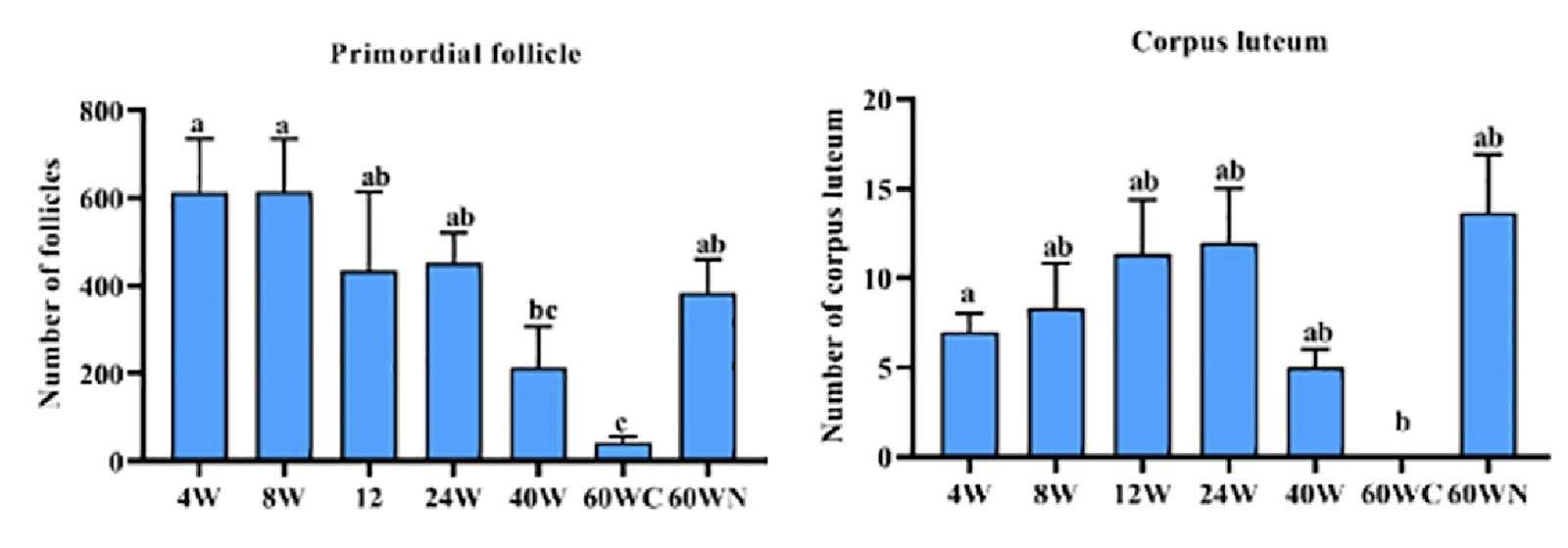
NMN administration enhances follicle development. The number of primordial follicles and corpus luteums span the ovarian cycle at different ages in female mice.
NMN decreases senescence marker in ovaries of mid-aged mice
The p16 protein slows cell divisions and proliferation during the progression of senescence. Recently, elevated p16 levels have been considered one of the indicators of ovarian aging. The present study showed high levels of p16 in ovarian follicles at 60 weeks. Huang and colleagues found that NMN diminished the levels of p16 in mouse ovaries. The drop in the ovary’s levels of p16 suggests that NMN alleviates ovary tissue senescence and protects it during aging.
The Jiangsu University researchers then show that the improvement to ovarian senescence by NMN treatment is likely due to the upregulation of critical cellular processes. For example, Huang and colleagues show increased mitochondria function and the recycling of cellular damage and debris (autophagy) in the ovaries of mid-aged mice exposed to long-term administration of NMN. In addition, the protein balance and the antioxidant capacity of follicles were restored, thereby keeping follicles relatively young.
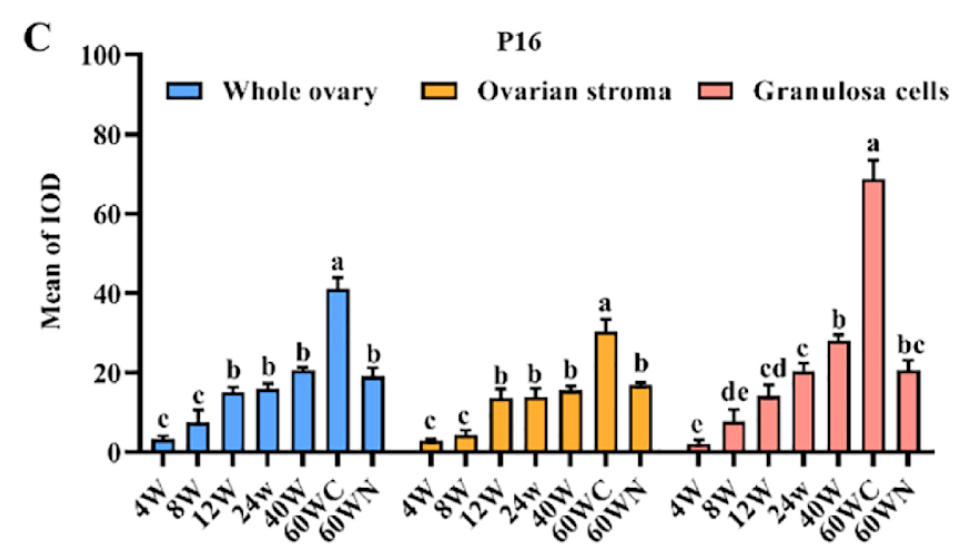
(Huang et al., 2021 | J Nutr Biochem.)
NMN administration decreases the levels of P16 protein. The protein level of p16 increases with age, reaching a peak in the 60-week control (60WC) group. Mice treated with NMN for 20 weeks beginning at 40 weeks of age (60WN) showed significantly decreased levels of p16.
These results indicate that the ovarian status of mice in the 60WN group was relatively younger after NMN supplementation.
Can a supplement a day keep ovarian aging at bay?
The importance of issues related to ovarian aging has been increasing progressively over the past several decades since, increasingly, more couples in all developed countries choose to postpone parenthood to more advanced female ages. This trend affects the likelihood of fertilization and conception, whether resulting from natural conception, conventional in vitro fertilization (IVF), or intracytoplasmic sperm injection (ICSI).
Since advanced male age seems to have little effect on the success rate for IVF/ICSI attempts using oocytes from young donors, much of the attention to improving the chances of parenthood has pointed to improving ovarian aging. Though treatment options need to be fine-tuned to reflect each woman’s condition, it is possible that supplementing with NMN can go a long way for improving the chances to experience some of life’s most miraculous adventures: pregnancy, childbirth, and parenthood.
References
Huang P, Zhou Y, Tang W, Ren C, Jiang A, Wang X, Qian X, Zhou Z, Gong A. Long-term treatment of Nicotinamide mononucleotide improved Age-related Diminished Ovary Reserve through enhancing the mitophagy level of granuloas cells in mice. J Nutr Biochem. 2021 Nov 18:108911. doi: 10.1016/j.jnutbio.2021.108911.
Nicotinamide mononucleotide (NMN) has been shown as safe in the short-term (up to six weeks); however, longer-term studies are required to prove safety.
Article first appears in NMN.com
Highlights
Research shows that nicotinamide mononucleotide (NMN) boosts physiological function to confer numerous health benefits. For example, NMN increased mitochondrial replication and genesis (mitogenesis), likely stemming from restoring more youthful patterns of gene regulation.
In doing so, NMN can also increase the activation of a protein deacetylase called Sirtuin1 (SIRT1), which improves the function of cell-rejuvenating proteins to reduce oxidative stress. Along those lines, some researchers have referred to NMN as the “holy grail of reversing aging.”[1]
The questions that continually pops into mind are “how safe is NMN for daily usage,” and furthermore, “what are the effects of taking NMN daily for months on end?” Well, the data acquired up to this point appear to show that NMN is safe for mice and for people to take.
Moreover, taking NMN for up to six weeks has shown no adverse health-related effects. Examples for these prospective conclusions include that dosages up to 1200 mg/day over a six-week time course confer no adverse health effects.
Twelve Weeks of NMN Was Proven Safe Without Side Effects
More evidence shows that NMN has no negative side effects, coming from data gathered from a clinical study testing the effects of NMN on skeletal muscle study over 12 weeks. Using 250 mg per day over a six-week time course in men over age 65 had no negative safety-related effects. Over a 12-week time course, 250 mg NMN daily enhanced muscle function and mobility. The physiological parameters measured in the study were blood chemistry markers, including liver enzymes and indicators of kidney function.
“We report that supplementation of 250 mg per day NMN for 12 weeks in healthy old men was safe, well tolerated, and significantly increased NAD+ and NAD+ metabolites in whole blood,” said Yamauchi and colleagues in their study. “Additionally, NMN induced improvements in muscle strength and performance. Thus, chronic oral administration of NMN could be an effective strategy for the prevention of age-related muscle disorders.”
In another study, Klein and colleagues from the Mayo Clinic in Rochester showed that administering 250 mg per day to women over the age of 65 for 10 weeks substantially improved metabolism. “NMN supplementation at 250 mg/day increases skeletal muscle insulin signaling, insulin sensitivity, and muscle remodeling in postmenopausal women with prediabetes who are overweight or obese,” said Klein and colleagues.
Ongoing Clinical Trials for NMN Safety
Currently, there are three ongoing clinical trials on the US Government-run clinicaltrials.gov; however, in other countries like China and Japan, no publicized safety trials are underway. One of the clinical trials titled “Safety and Pharmacokinetics of Nicotinamide Mononucleotide (NMN) in Healthy Adults” is active with healthy volunteers. The study is being conducted by Vitalab Clinics in Toronto, Ontario, Canada, and results have not yet been posted. The estimated completion of this study is set for March 15, 2022.
Another study published on clinicaltrials.gov is the safety evaluation titled “Evaluate the Efficacy and Safety of Uthever NMN (Nicotinamide Mononucleotide, a Form of Vitamin B3).” This study from the Swasthiye Clinic and Research Center in India on the effect of NMN on aging adults has been completed, but the results have not yet been published the results.
The third and final study published to the Clinical Trials website is titled “To Evaluate the Efficacy and Safety of NMN as an Anti-ageing Supplement in Middle Aged and Older (45-69 Years) Adults.” The study evaluated the safety of 900 mg of NMN per day over the course of 60 days. Although this clinical trial was completed in September 2021, results have not yet been made available.
Long-Term NMN Safety Trials Are Required
The bottom line is that, to date, no single study of NMN’s safety has shown that the compound has any adverse effects when it comes to humans’ blood chemistry or cardiovascular health. Not only that, but NMN has been shown to improve muscle function, immunity, and metabolism. The only possible issue that scientists need to confront is what the long-term effects of taking NMN have on the body.
For example, we do not yet understand if any negative health impacts may come from using NMN over the course of a year or more.
References